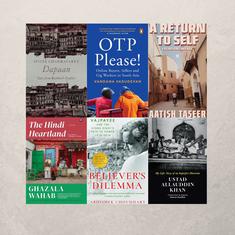The Saga of Satisar by Chandrakanta is a historical, anthropological, and ethnographic magnum opus which explores Kashmir and Kashmiriyat throughout the 20th century. The writer takes us through 1930s’ Srinagar with detailed descriptions of the social and political unravelling of Jammu & Kashmir leading up to the end of 20th century, with humane stories that constantly remind us of someone we have met. The book opens up in Srinagar and slowly spreads out to different villages of Kashmir, Ladakh, Jammu, Poonch, and even follows the nomadic lives of the Bakarwal community. Chandrakanta writes her characters in such a way that makes you feel like you’ve known them forever.
But she isn’t afraid to call a spade a spade, either, a feature that is missing from several accounts and writings of Kashmir. Chandrakanta examines the life under monarchy, the excitement within both the Muslim and Pandit communities about Sheikh Abdullah’s promises of a “New Kashmir” when the National Conference was being set up, the after-effects of the Partition and the Kabali attacks of 1947, the disillusionment with state and centre politics, the situation turning sour in the 1980s, the forced migration out of the state of Kashmiri Pandits, and the violence in 1990s’ Kashmir which split Kashmir and its Kashmiriyat into two: a Kashmir that even a Kashmiri Muslim no longer recognized, a Kashmir that existed in refugee camps. She has an acute understanding of the deep-seated psychological and societal underpinnings of 20th century Kashmir. She recognises and points us towards the ripples that led Kashmir where it is today – whether it is the loss of young lives in the state, or the way elders live in Kashmir or elsewhere, who are the last generation to have known Kashmir before the “worm of fear was wriggling its way into everyone’s heart”.
Chandrakanta constantly brings us various ancient fables, myths and anecdotes that many Kashmiri children grew up listening to, including stories of Lal Ded, Nund Rishi, Habba Khatoon or the one about the discovery of Amarnath caves, stories of how Herath, Yakshamavas, Navreh, Moharram and many other festivals came to be, narratives about the contribution of Guru Teg Bahadur to Kashmir’s history, the theft of the holy relic from Hazratbal Shrine, the shrine at Charar-e-Sharif as the symbol of Kashmiriyat-twice-destroyed and still standing, myths and fables about Himal-Nagraj, Narcissus and the bee.
The writer compares the violent tribulations in the valley to the return of the demon Jalodbhav, who, according to the myth, was killed after Rishi Kashyap prayed to the gods and they drained out the water from Satisar Lake so that the valley came into being. The title draws its name from the myth of Satisar found in the sixth century text Neelmat Purana. All these add a layer of richness to the multiple stories of multiple families and characters that come together beautifully.
What the writer remembers
Chandrakanta, the Kashmiri author is known for writing more than fifty books in Hindi, some about Kashmir, some drawn from her life elsewhere. The Saga of Satisar, originally Katha Satisar was published in Hindi in 2007, and has now been translated into English by Ranjana Kaul. The novel is reminiscent of her A Street in Srinagar (Ailan Gali Zinda Hai) in terms of style. Chandrakanta has had an illustrious career in Hindi literature and the translations of her work are important because they break open the world of Kashmir in a previously unexplored manner.
I cannot help but recall the book’s aesthetic counterparts in the visual medium, because it comes across as a combination of the Doordarshan television show Buniyaad – which depicted the aftermath of the Partition through the life of a joint family – and Claude Lanzmann’s Holocaust documentary Shoah. Having encountered her work for the first time at a book reading in 2013, my involvement with Chandrakanta’s works began with her voice rather than on paper. The experience ended up influencing the way I read her, which is in the tone of her voice. She was the only woman writer in the panel that day, and one of the few Kashmiris writing in Hindi as well. She can be considered a commanding voice in Hindi literature, just as Amrita Pritam is in Punjabi and Hindi literature, and Ismat Chughtai in Urdu.
The book finds its contemporaries in Salman Rushdie’s Shalimar the Clown, Siddhartha Gigoo’s The Garden of Solitude, and Mirza Waheed’s The Book of Gold Leaves, as well as in Yashpal’s Jhootha Sach (translated into English as This Is Not That Dawn). It has the proportions of a Russian novel because of style, length and the number of lives it traces through a large time period. Those who read this book will nevertheless scream, “Rashomon!” – because at the end of the day, this book attempts to encapsulate almost everything, and I mean everything, that there is to know about the life, culture, history, myths, and rituals of Kashmiri Pandits, including their relationships with Kashmiri Muslims, Sikhs, Ladakhis, and Dogras in Jammu & Kashmir throughout the 20th century. Even if this magnanimous effort misses out on some oral narratives, alternate histories, and political views, the book does not feel as though it lacks anything.
Chandrakanta’s minute observations on human nature remind one of Chekhov, but the length – yes, I am obsessing over the length of this book because it takes patience to read it, and then I thought about the kind of patience it must have taken for her to write it. Working the memory frantically, all the research that went into it, the sheer amount of recalling the author must have had to perform.
How much of it is autobiographical? Did Chandrakanta suffer while writing it? Did the memories gnaw at her soul while writing the sections that gnawed at me, her reader? I read parts of it to my mother who cried after hearing them. I read a section describing children’s lives in exile to my sister who let out a scream when she saw the name and description of the migrant colony where we grew up.
The lives not narrated
Chandrakanta has sealed the lived memories of several generations of different families inside the pages of this book. She also addresses the prejudices persistent in the Kashmiri Pandit community at the time, which included class-related responses like frowning on certain professions (cooking or tailoring, for instance), the patriarchy did not let women get a proper education till the 1950s, early marriage, sexual harassment, several restrictions on women, the prejudices against Pandits whose ancestors had previously converted to Islam during the reign of tyrannical kings.
But Chandrakanta highlights the breakthroughs as well. She draws maps that will lead you to every single Kashmiri life one has known and encountered, which include a couple in an inter-religious marriage, a young woman named Katya rebelling against her family and society to be able to study in a co-educational college and paving way for others, a woman who gets divorced from an abusive husband, a woman who lost her son to jihad, multiple women from different communities who were raped in 1947 and in the 1980s-90s, but whose souls found a way to live again.
The sections dedicated to Katya going through menstruation for the first time, and another one where the same Katya, now a grown-up woman, arrives at a clearer understanding of sexuality, remain remarkable because one reads many things about many Kashmiris in many books, but somewhere between the LOC, terrorism and calls for freedom, the forgotten lives of women never show up. Chandrakanta makes sure that they are remembered for being Katya, the rebel turned doctor who reminds one of Jane Austen’s Elizabeth Bennett, Khurshid the midwife who never differentiated between a Hindu mother or a Muslim mother, Rubaiya, who was kidnapped and held on to as ransom for the release of five JKLF members, Lalli, who spent her life following commands and fulfilling household duties without question, Naseem, who was raped for “not wearing a burqa and riding a bicycle to work every day”, Krishna Misr,i who was one of the first women who received firearm training after the Kabali attacks of 1947, and many more.
This is not a work of sentimentality. The author here seems to be in a race against time, to fiercely and minutely preserve all that one remembers distantly or closely about Kashmir, the region that cannot be understood without understanding its people and their lived past. The book starts off as a slow read and it is initially difficult to remain engaged with it, but a patient reading of the first hundred pages is worth the effort because after this it opens up itself up, allowing the layers to be peeled.
For me, a book which started as an exploration of Kashmir’s historical and political past morphed into a written description of my ancestors’, grandparents’ and parents’ lives. Eventually, I felt like I had woken up from a deep sleep after hearing my grandmother telling me, once again, how Satisar became Kashmir.

The Saga of Satisar, Chandrakanta, translated from the Hindi by Ranjana Kaul, Zubaan Books.










